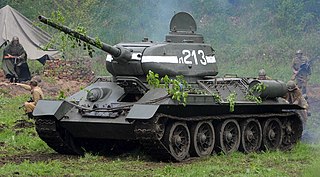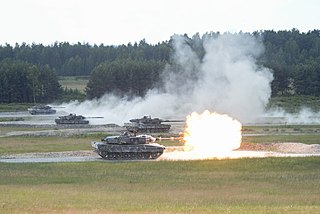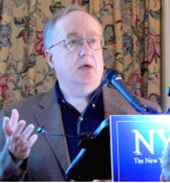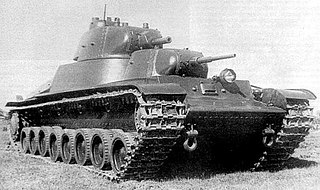Related Research Articles

The T-34 is a Soviet medium tank from World War II. When introduced, its 76.2 mm (3 in) tank gun was more powerful than many of its contemporaries, and its 60-degree sloped armour provided good protection against anti-tank weapons. The T-34 had a profound effect on the conflict on the Eastern Front, and had a long-lasting impact on tank design. The tank was praised by multiple German generals when encountered during Operation Barbarossa, although its armour and armament were surpassed later in the war. Its main strength was its cost and production time, meaning that German panzer forces would often fight against Soviet tank forces several times their own size. The T-34 was also a critical part of the mechanized divisions that formed the backbone of the deep battle strategy.

The IS tanks were a series of heavy tanks developed as a successor to the KV-series by the Soviet Union during World War II. The IS acronym is the anglicized initialism of Joseph Stalin. The heavy tanks were designed as a response to the capture of a German Tiger I in 1943. They were mainly designed as breakthrough tanks, firing a heavy high-explosive shell that was useful against entrenchments and bunkers. The IS-2 went into service in April 1944 and was used as a spearhead by the Red Army in the final stage of the Battle of Berlin. The IS-3 served on the Chinese-Soviet border, the Hungarian Revolution, the Prague Spring and on both sides of the Six-Day War. The series eventually culminated in the T-10 heavy tank.

The Kliment Voroshilov tanks are a series of Soviet heavy tanks named after the Soviet defence commissar and politician Kliment Voroshilov who operated with the Red Army during World War II. The KV tanks were known for their heavy armour protection during the early stages of the war, especially during the first year of the German invasion of the Soviet Union. In certain situations, even a single KV-1 or KV-2 supported by infantry could halt German formations. The German Wehrmacht at that time rarely deployed its tanks against KVs, as their own armament was too poor to deal with the "Russischer Koloss" – "Russian Colossus".

The BT tank was one of a series of Soviet light tanks produced in large numbers between 1932 and 1941. They were lightly armoured, but reasonably well-armed for their time, and had the best mobility of all contemporary tanks. The BT tanks were known by the nickname Betka from the acronym, or by its diminutive Betushka. The successor of the BT tanks was the famous T-34 medium tank, introduced in 1940, which would replace all of the Soviet fast tanks, infantry tanks, and light tanks in service.

The Panzerkampfwagen III , commonly known as the Panzer III, was a medium tank developed in the 1930s by Germany, and was used extensively in World War II. The official German ordnance designation was Sd.Kfz. 141. It was intended to fight other armoured fighting vehicles and serve alongside and support the similar Panzer IV, which was originally designed for infantry support.

The SU-85 was a Soviet self-propelled gun used during World War II, based on the chassis of the T-34 medium tank. Earlier Soviet self-propelled guns were meant to serve as either assault guns, such as the SU-122, or as tank destroyers; the SU-85 fell into the latter category. As with the other AFVs in the SU series, the designation "85" refers to the vehicle's main armament, the 85 mm D-5T gun.

The 7TP was a Polish light tank of the Second World War. It was developed from the British Vickers 6-ton. A standard tank of the Polish Army during the 1939 Polish Campaign, its production did not exceed 150 vehicles. Its chassis was used as the base for the C7P artillery tractor.

Armoured warfare or armored warfare, is the use of armoured fighting vehicles in modern warfare. It is a major component of modern methods of war. The premise of armored warfare rests on the ability of troops to penetrate conventional defensive lines through use of manoeuvre by armoured units.

Tanks were initially deployed in World War I, engineered to overcome the deadlock of trench warfare. Between the two world wars, tanks were further developed. Although they had demonstrated their battlefield effectiveness, only a few nations had the industrial resources to design and build them. During and after World War I, Britain and France pioneered tank technology, with their models generally serving as a blueprint for other countries. However, this initial advantage would slowly diminish during the 1930s, shifting in favor of the Soviet Union and, to a lesser degree, Nazi Germany.

The T-40 amphibious scout tank was an amphibious light tank used by the Soviet Union during World War II. It was armed with one 12.7 mm (0.5 in) DShK machine gun. It was one of the few tanks that could cross an unfordable river without a bridge.

The T-50 was a light infantry tank built by the Soviet Union at the beginning of World War II. The design for this vehicle had some advanced features, but was complicated and expensive, and only a short production run of 69 tanks was completed.

T-20 armored tractor Komsomolets(Bronirovannyy gusenichnyy tyagach Komsomolets T-20), an armored continuous track tractor, the T-20 was a prime mover vehicle used by the Soviet Union during the Winter War and World War II.

The KhTZ-16 was a Soviet improvised fighting vehicle of the Second World War, built on the chassis of an STZ-3 tractor. The vehicles were built in Kharkiv until the factory was evacuated to the east, at which time production moved to Stalingrad. No less than 809 vehicles were planned, but no more than about 60-90 were actually built. Some vehicles were used in the fighting around Kharkiv in October 1941, but were quickly lost in battle against Axis forces.

Steven Joseph Zaloga is an American author and defense consultant. He received a bachelor's degree cum laude at Union College and a master's degree at Columbia University, both in history.

The 76 mm tank gun M1940 F-34 was a 76.2 mm Soviet tank gun used on the T-34/76 tank. A modified version of the gun, the 76 mm tank gun M1941 ZiS-5, was used on KV-1 tanks during World War II. Nowadays, the two versions are often referred to just by their factory designations, as "F-34" and "ZiS-5", respectively.

Tanks were an important weapons system in World War II. Although tanks in the inter-war years were the subject of widespread research, few were made, in just a few countries. However, during World War II, most armies employed tanks, and thousands were built every month. Tank usage, doctrine, and production varied widely among the combatant nations. By war's end, a consensus was forming on tank doctrine and design.

The T-43 medium tank was a prototype Soviet medium tank developed during the Second World War as a possible replacement for both the T-34 medium and KV-1 heavy tanks. The project's aim was to build a medium tank with heavier armour, but German advances in tank technology proved better countered by a more heavily armed T-34-85 and the T-43 was cancelled.

The T-100 was a Soviet twin-turreted heavy tank prototype, designed in 1938–39 as a possible replacement for the T-35 heavy tank. The T-100 was designed by N. Barykov's OKMO design team at S.M. Kirov Factory No. 185 in Leningrad. The T-100 was originally conceived with three turrets and was eventually built with two. It was in competition with a similar design, the SMK, but neither was adopted and instead a single turret version of the SMK was ordered as the KV-1. All three prototypes were tested at the same time in the Battle of Summa during the Winter War with Finland.

The L-11 76.2 mm tank gun was a Soviet tank gun, used on the earliest models of the T-34 Model 1940 medium tank and KV-1 Model 1939 heavy tank during World War II.

The IS-2 is a Soviet heavy tank, the second of the IS tank series named after the Soviet leader Joseph Stalin. It was developed and saw combat during World War II and saw service in other Soviet allied countries after the war.
References
- ↑ Chamberlain, Peter; Doyle, Hilary L.; Jentz, Thomas L. (1993) [1978]. Encyclopedia of German Tanks of World War Two: A Complete Illustrated Directory of German Battle Tanks, Armoured Cars, Self-propelled Guns and Semi-tracked Vehicles, 1933–1945 (rev. ed.). London: Arms and Armour Press. ISBN 1-85409-214-6.
- ↑ Kliment, Charles K.; Francev, Vladimír (1997). Czechoslovak Armored Fighting Vehicles. Atglen, PA: Schiffer. ISBN 0-7643-0141-1.
- ↑ Twenty captured 7TP were used by Germans as PzKpfw 7TP 731 (p).
- ↑ David R. Higgins and Ricard Chasemore. Panzer II vs 7TP: Poland 1939, Osprey Publishing, 2015. ISBN 9781472808837.
- 1 2 Steven J. Zaloga and James Grandsen. Soviet Tanks and Combat Vehicles of World War Two, London: Arms and Armour Press, 1984. ISBN 0-85368-606-8.
- ↑ "Russia's BT-7 Fast Tanks" at wwiivehicles.com. URL accessed 2006-07-25.
- ↑ Zaloga, Steven J., James Grandsen (1983). T-34 in Action, p.40. Carrollton, Texas: Squadron/Signal. ISBN 0-89747-112-1.
- ↑ Tomczyk, Andrzej (2007) [2002]. Japanese Armor Vol. 2. AJ Press. ISBN 978-8372371119.
- 1 2 3 4 "T-34-76 Model 1940", at onwar.com. URL accessed 2006-07-25.